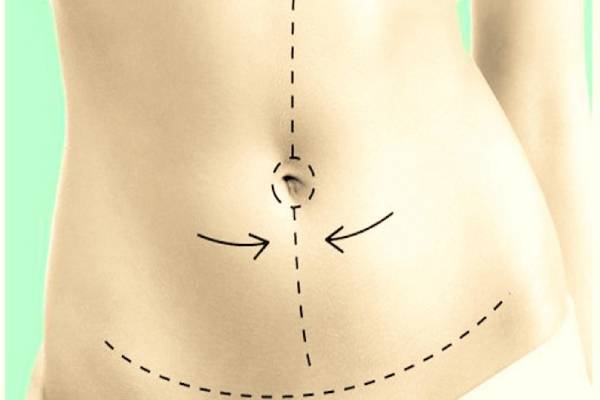Table of Contents
Abdominoplasty or Tommy Tuck is a cosmetic surgery used to slim and tighten the abdomen. This surgery involves removing excess skin and fat from the abdomen and is performed to tighten the muscles of the abdominal wall.
There are different types of abdominoplasty surgery that can be performed according to the patient’s condition and the desired result.
To make an informed decision about abdominoplasty surgery, the patient needs to ask all the questions of the treating physician.
To prepare the patient for abdominoplasty surgery, the surgeon recommends that you stop smoking or taking medications and supplements that can increase bleeding. These medications can include herbal supplements, anti-inflammatory drugs, or aspirin.
Abdominoplasty causes scarring in the abdomen. The length of the resulting scar (which is along the bikini line) depends on the amount of excess skin. Mini-abdominoplasty causes a smaller scar by removing minimal extra skin compared to full abdominoplasty (which is cut head-to-head in the lower abdomen).
Your plastic surgeon will talk about all of these options when you go for advice. You and your surgeon will talk about your desired results and the surgeon will determine the appropriate method when consulting.
Abdominoplasty should not be confused with liposuction (cosmetic surgery used to remove fat deposits). The surgeon may perform liposuction as part of an abdominoplasty.
Who are the best candidates for abdominoplasty surgery?
Abdominoplasty surgery is suitable for men and women who are generally in good general health and have a balanced weight.
Non-smokers and those who do not suffer from chronic diseases such as heart disease, diabetes, high blood pressure, etc.
Women who have stretched muscles and skin on their abdomen after multiple pregnancies may need abdominoplasty to tighten their abdominal muscles and shrink their skin.
Abdominoplasty is also suitable for men or women who have been obese at some point in their lives and have lost significant weight but still have excess fat deposits in the abdomen and loose skin.
When should abdominoplasty surgery be avoided?
1. If the patient is a woman who is still planning to have a baby, she should postpone abdominoplasty surgery until after pregnancy, because during surgery, the vertical muscles of the abdomen contract and come closer together, and future pregnancies can cause These muscles to separate once again.
2. If the patient still intends to lose significant weight, he should wait until his weight stabilizes and is in the range of weight health.
What will the patient’s abdomen look like after abdominoplasty surgery?
Abdominoplasty, or abdomen removal surgery, removes excess skin and fat from the abdomen and tightens the abdominal muscles to create a flat, firm abdomen with a better contour and shape. Approximately 2-3 months after surgery, the scar may become red and slightly raised due to the formation of collagen in the scar.
Natural symptoms that may occur after abdominoplasty surgery:
Abdominal cramps, bruising, swelling and redness, tingling, burning or intermittent pain are all normal symptoms. Painkillers and muscle relaxants help the patient cope with any discomfort. Severe and persistent pain should be reported to the treating physician immediately.
Hypersensitivity of the skin or numbness: These are normal symptoms and gradually disappear over time.
Shiny or itchy skin: Swelling can cause the skin to become shiny in the area being operated on.
As the healing process progresses, a slight to severe itching sensation may occur.
Antihistamines such as Benadryl can help relieve severe and persistent itching. If the skin becomes red and hot to the touch, you should contact your doctor immediately.
Asymmetry: Both sides of the body may go through the healing process differently, and one side of the body may be completely different from the other in the days after surgery.

Which surgeons perform abdominoplasty?
Abdominoplasty (Tommy Tuck) is a cosmetic surgery because it aims to improve the patient’s appearance. The patient can choose a cosmetic surgeon or a plastic surgeon. Most cosmetic surgeons and plastic surgeons can perform Tommy Tuck, but only a few are specialized surgeons.
What happens before abdominoplasty surgery?
Before surgery, your doctor will review the patient’s medical records, tests, and medications that he or she is currently taking. The photo is taken before the surgery and any questions of the patient are answered.
What happens during abdominoplasty surgery?
During abdominoplasty surgery, the surgeon makes incisions in the lower abdomen to remove excess skin and fat. Then, after removing excess tissue, fat, and skin, the patient’s umbilicus is repositioned and sutured.
What happens after abdominoplasty surgery?
If a complete abdominoplasty is performed, the patient will have a global scar in the lower abdomen, as well as a wound around the navel.
The following problems are common after abdominoplasty surgery:
Inability to stand upright that will resolve over time
Existence of pain and bruising in the abdomen
Abdominal numbness for several months to several years
Temporary swelling above the wound (in the first six weeks there are prominent red sores that eventually fade).
What are the risks of abdominoplasty surgery?
Every invasive surgery performed on the body carries different risks.
Surgical risks include a variety of factors, including:
Accumulation of fluid under the skin (serum), but placing drainage tubes (drainage) after surgery can help reduce the accumulation of excess fluid. Your doctor may also use a needle and syringe to remove the fluid.
Sometimes the healing process in the sutured area is short or stitches begin to separate, to prevent infection of the sutures, antibiotics may be prescribed to the patient during and after surgery.
The cleft palate causes permanent scarring, but the scar is located along the bikini line and is easily hidden. The size and manifestation of scars vary from person to person.
Adipose tissue damage (necrosis) during surgery: Live adipose tissue deep in the patient’s skin in the abdomen may be damaged or even die, smoking increases the risk of necrosis.
Changes in the sensory nerves of the abdominal skin: Displacement of the abdominal tissues can affect the nerves in the abdomen and rarely in the upper thighs. The patient is more likely to experience numbness or less sensitivity in these areas. This complication usually subsides in the months after surgery. Depending on the size of the area being operated on, the sensation of that area may return on its own or a surgical procedure may be needed to restore the sensory nerves in that area.
How long does it take for the abdominal muscles to heal after surgery?
According to many people who have experienced abdominoplasty surgery, it takes approximately one to two months (sometimes even just six weeks) for your wound to heal, during which time you should try not to put too much pressure on the patient’s abdomen.
Is the abdomen of someone who has had an abdominoplasty recognizable?
The scars are quite obvious in some cases but can only be seen in a swimsuit.
Inverted ulcers “T” extend upwards and in the center of the abdomen.
A clear umbilical scar may make the umbilicus look artificial.
last word
Dear patients, there may be questions that are not mentioned in the above cases, but there is no need to worry because our colleagues are at the service of dear patients around the clock in the Amitis.
Follow-up of our colleagues is not limited to the surgical and pre-surgical process, and in the post-surgery and recovery period, the patients’ condition is followed, and in case of any problems, the Amitis team is ready to serve the esteemed patients.




